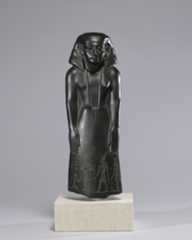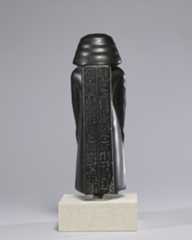Statue of a Vizier, Usurped by Pa-di-iset
(Ancient Egypt and Nubia )
A remarkable example of the re-use of a work of art, reflecting the course of Egypt's long history, this statue was originally carved to commemorate a powerful government official. A thousand years later the inscription naming this unknown man was erased, and a carved scene was added depicting its new owner, Pa-di-iset, son of Apy, worshipping the gods Osiris, Horus, and Isis. From a text on the rear of the statue we learn that Pa-di-iset was a diplomatic messenger to the neighboring lands of Canaan and Peleset (Palestine).
Inscription
[Translation] caption of the scene on the kilt: Ka of Osiris: Pa-di-iset, the justified, son of Apy.
[Translation] on the back pillar: The only renowned one, the impartial envoy of Philistine Canaan, Pa-di-iset, son of Apy.
ProvenanceProvenance (from the Frenchprovenir, 'to come from/forth') is the chronology of the ownership, custody, or location of a historical object. Learn more aboutprovenance at the Walters.
Maurice Nahman, Cairo, [date and mode of acquisition unknown]; Henry Walters, Baltimore, 1928, by purchase; Walters Art Museum, 1931, by bequest.
Exhibitions
| 1998-2001 | Highlights from the Collection. The Walters Art Gallery, Baltimore. |
| 1984 | The Taste of Maryland: Art Collecting in Maryland 1800-1934. The Walters Art Gallery, Baltimore. |
Conservation
| Date | Description | Narrative |
|---|---|---|
| Treatment | cleaned; coated; other | |
| 5/1/1950 | Treatment | cleaned |
| 5/2/1984 | Treatment | rehoused; cleaned |
| 5/2/1984 | Examination | examined for exhibition |
| 11/24/1998 | Examination | survey |
Geographies
Egypt, Delta (Place of Origin)
Measurements
12 x 4 1/16 x 4 1/2 in. (30.5 x 10.25 x 11.5 cm)
Credit Line
Acquired by Henry Walters, 1928
Location in Museum
Accession NumberIn libraries, galleries, museums, and archives, an accession number is a unique identifier assigned to each object in the collection.
In libraries, galleries, museums, and archives, an accession number is a unique identifier assigned to each object in the collection.
22.203

 Creative Commons License
Creative Commons License

